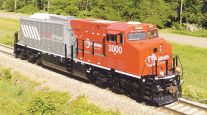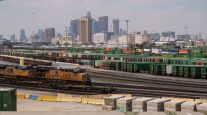Shortage of Freight Rail Locomotives Seen on Emissions Rules, Production Cutbacks
This story appears in the Dec. 15 print edition of Transport Topics.
A shortage of locomotives to power intermodal and other rail freight is looming because of restrictions on future production and current constraints stemming from carrier delays, industry experts said.
Jason Kuehn, vice president at consultant Oliver Wyman and a former rail executive, and Stephens Inc. analyst Justin Long told Transport Topics the fleet will be constrained because Caterpillar Inc.’s Electro Motive Diesel unit isn’t offering a locomotive compliant with tougher Tier 4 Environmental Protection Agency emissions standards that apply to engines made after Jan. 1. Electro Motive is one of only two manufacturers,
“There is a real shortage of locomotives that is anticipated,” Kuehn told TT, because continued delays could block the availability of locomotives from keeping pace with rising rail demand.
The absence of an Electro Motive Diesel product would remove an average of 208, or 28%, of locomotives delivered over the past decade, Kuehn said. In the same period, a General Electric unit’s deliveries averaged 543 locomotives, which trails the pace of 620 road locomotives that are needed just to replace the existing road fleet as engines reach retirement age or break down, he said.
“A lot of older locomotives are coming out of storage,” said Long, noting that the 10% of units idle last year have been pressed into service.
He said locomotive supply “is a major issue headed into next year,” putting the industry on the brink of a shortage.
Industrywide, train speeds this year have slowed about 2 miles per hour to 22 mph. Carriers have tied the slowdown to an unexpected surge in freight levels. Intermodal, accounting for 43% of rail shipments, is on a record pace through late November, rising 5.2%.
“The most important thing to watch is how velocity trends,” Long said. He cited a recent Union Pacific estimate that improving train velocity 1 mph frees up as many as 250 locomotives.
When asked for comment by TT, the railroads offered various responses.
“The lack of competition is certainly putting pressure on the overall domestic production capacity, which is a concern, given current demand in the industry,” said Melanie Cost, a CSX spokeswoman. “A key component of CSX’s strategy to handle growing customer demand is to improve existing locomotive availability and asset utilization.”
She noted that despite early winter storms, locomotive availability last month was the second-highest period this year.
Norfolk Southern declined to comment. BNSF Railway directed questions to the Association of American Railroads trade group.
“AAR is very much aware of the situation along with its member railroads as the industry goes into 2015,” spokesman Ed Greenberg said.
Union Pacific Chief Financial Officer Robert Knight said last month that locomotive power “has not been a constraint of ours.”
A spokeswoman for the railroad said the company expects to continue buying new engines from both manufacturers.
Kuehn said he believed both manufacturers were sold out this year, and that GE is nearly there for 2015.
Both analysts said the 2015 situation is uncertain because neither manufacturer will discuss orders or sales.
Kuehn estimated that a shortage could reach about 450 locomotives next year and double that amount in 2016 because of rail-traffic growth and the temporary absence of Electro Motive Diesel.
GE has more than 1,000 Tier 4 compliant locomotives on order for delivery within three years.
“GE Transportation will be ready to ship EPA Tier 4 compliant locomotives on Jan. 1, 2015,” Vice President Tina Donikowski said.
Its Tier 4 locomotive reduces emissions by 70%, she said, with the bulk of the savings through recirculating exhaust gases back into the engine, which “required us to build a next generation cooling system.”
GE has spent more than $600 million on locomotive technology, she said.
“After talking with customers about their needs for 2015 and 2016, it looks like industry demand for new locomotives will be very low,” said Amy Everett, a spokeswoman for Caterpillar’s Progress Rail unit that includes Electro Motive Diesel. She said that Electro Motive Diesel has a product “that we believe meets Tier 4 requirements, but we do not believe it is the best long-term solution for fuel economy.”
She said the company is targeting the second half of 2016 to introduce its Tier 4 engine.
Kuehn emphasized efforts to cope with delays, saying “railroads are spending billions of dollars to address the [congestion] problem,” with capital spending and hiring new train-crew workers.
“If the railroads cleaned up their issues around Chicago, that would help tremendously,” particularly during the winter, Kuehn said.
Cost noted locomotive availability is especially important in cold winter months, since engine failures increase when temperatures are low.
Kuehn also noted another impediment to expanding the fleet. Tier 4 locomotives won’t improve fuel efficiency over the existing Tier 3 fleet, removing incentives to purchasing them.
That’s a contrast to trucking, where fuel savings on new trucks can mitigate the impact of higher costs.




